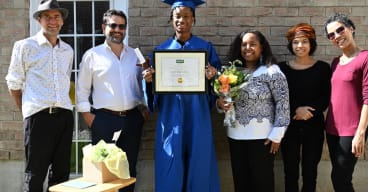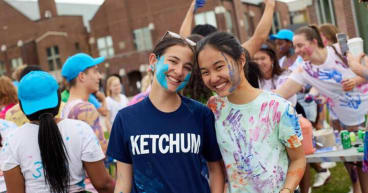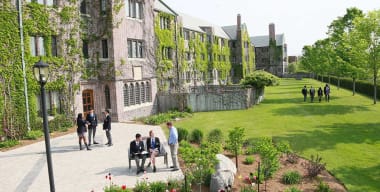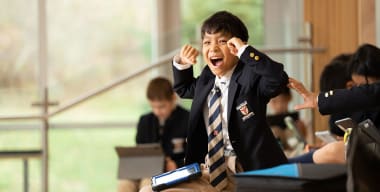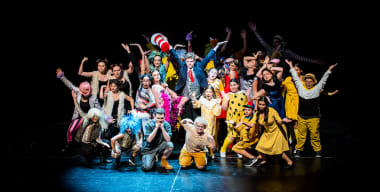The three founders of Clanmore Montessori School in Oakville, Ontario, are convinced that's true. "When we select students we're blind to superficial differences and almost wholly focused on achieving 'aptitudinal diversity,'" says Cathy Sustronk, co-founder and co-director at Clanmore Montessori School.
Elaine Delsnyder, also the school's co-founder and co-director, emphasizes the point: "We've come to the conclusion that an academic environment where there is aptitudinal diversity, meaning a richness of different types of talent and natural gifts, is the type of setting where the individual can achieve and experience the very real pleasure of excelling and sharing knowledge with each other."
Different Intelligences, Diverse Aptitudes
The thinking at Clanmore is strongly influenced by, among other writings, that of American scholar Howard Gardner (no relation to the author), professor of cognition and education at the Harvard Graduate School of Education. Clanmore also has a keen interest in the unusual student review process of McMaster University's Michael G. DeGroote School of Medicine in Hamilton, Ont.
In Frames of Mind: The Theory of Multiple Intelligences, Gardner makes convincing arguments that there are different types of intelligence. We've all encountered the young person who has trouble with math but who, at the same time, is a brilliant writer, a talented musician, or a gifted speaker. Gardner suggested that there is a broad range of aptitudes in the worldwide population. He says this may have been due, in some measure, to the need of the gene pool to continually evolve or adapt to new situations as they emerged. Too often in the past, Gardner argues, we have focused on the logical/mathematical capacities and ignored other equally important types of mental acuity.
At the DeGroote School of Medicine, educators concluded that candidates for medical school tended to come from the same narrow type of science background. The authorities wondered what would happen if they added students who had other types of training. In a move that garnered attention around the world, McMaster sought to recruit "unconventional" candidates. All potential students had to be exceptionally bright, of course–just not bright in exactly the same things. In the current class of 2012, while the largest group still comes from a science background, the student body is seasoned with students who have arts, education, engineering, and business degrees. Having a mix of students with various and diverse aptitudinal capacities enriched the entire educational process, and the quality of graduates, their social skills, and their problem-solving abilities improved. The university is so proud of this particular aspect of its intake process that it publishes the backgrounds of students by year.
Once you start with the premise that people are, by their very nature, different in their capacities to carry out certain tasks, there may develop a healthy skepticism about standardized testing, which many would argue favours students in the linguistic/mathematics sphere. At Clanmore, for example, teachers stay away from intelligence tests. They assume that the normal, healthy child will bring some desirable qualities to the mix of abilities within the classroom environment. "Our everyday observation and working alongside the children inform us of their standard of achievement in a way that testing cannot possibly achieve," says school co-founder and principal Grace Kidney. "By making assumptions–even informed assumptions–too early about individual students, we are likely doing the particular student and society as a whole a disservice."
Learning in Groups to Capitalize on Differences
The problem with most curricular models is they make an implicit assumption that the recipients of the information are almost identical. Even testing assumes that the students will absorb information in exactly the same way and that their response to standardized questions can be anticipated.
Human beings are more complex than this paradigm presupposes. Some students are naturally disposed to active learning. Others may respond more fully to visual and auditory cues. Some are highly verbal while others are more thoughtful and less (apparently) articulate. That's why learning in groups, where students can capitalize on their inherent differences, is so often advantageous.
An article in the Review of Educational Research journal, entitled "Effects of Small-Group Learning on Undergraduates in Science, Mathematics, Engineering, and Technology," presented evidence that students learned best "through active, collaborative, small group work inside and outside the classroom."
In fact, studies have consistently found that cooperation has favourable effects on achievement and productivity, psychological health and self-esteem, and attitudes toward learning, according to the article. In short, just as Clanmore and McMaster have discovered, there is a synergistic effect to group learning when the students themselves have a diversity of propensities and aptitudes. To ignore this concept is to cripple the educational enterprise.
So when we talk about "diversity," we would do well to remember that the true dimensions of a student's capacity and unique abilities lie beneath the surface, invisible to the eye. Often an individual student's true ability will be unleashed in constructive, cooperative work with others who have different and complementary strengths. In fact, diversity (or range of aptitudes) is the very fabric that makes a complex culture possible. The teacher or the curriculum designer who could employ the power of this concept in the classroom would transform education.

